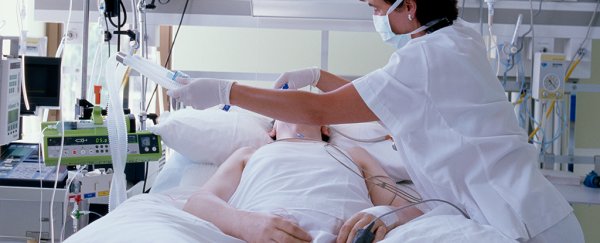Coronavirus infections, like those caused by the Severe Acute Respiratory Syndrome coronavirus (SARS-CoV-1 and SARS-CoV-2) and the Middle East respiratory syndrome coronavirus (MERS), can cause death in humans through significant tissue damage in major organs, especially the lungs, raising the risk of organ failure.
A detailed description of the mechanisms responsible for this damage is still far from clear, with each strain possessing unique characteristics that present distinct risks of infection and death.
Our knowledge of the COVID-19 pandemic is constantly updated as we learn more, but early reports have found roughly 5 percent of those infected with the virus have required intensive care, with death rates varying broadly based on region, demographics, and hospital care.
This makes it far less deadly than the MERS coronavirus, and slightly less severe than SARS-CoV-1. Unfortunately, SARS-CoV-2's unusual transmission rate has made it harder to contain, putting a greater percent of the global population at risk.
The widespread impact of the 2020 pandemic has inspired vast amounts of research to attempt to explain, and potentially treat, the damage caused by the novel coronavirus.
While studies continue, a picture is emerging of acute injury to tissues throughout the body, with the most debilitating occurring in the thin tissues making up the lung's tiny air sacs, or alveoli.
By triggering an immune response in these fragile tissues, inflammation and a build up of white cells prevents them from exchanging gases efficiently, giving rise to pneumonia.
A number of studies hint that other body systems, such as the heart and blood vessels, could also be damaged by a serious SARS-CoV-2 infection, potentially contributing to life-threatening system failure. One study concludes the virus could raise the risks of unusual clotting of the blood itself.
Why doesn't everybody with a SARS-CoV-2 infection die?
One of the big unanswered questions is why some people die of COVID-19, while most seem are relatively unaffected by the virus.
Initial infection is known to take place through a common receptor that dots the surface of many tissues throughout the body. Called angiotensin-converting enzyme 2 (ACE2), it usually plays a role in helping manage blood pressure. Unfortunately, it's what SARS-CoV-2 uses as an unlocked window to gain entry.
Most infections start by latching onto this receptor in cells lining the upper respiratory tract, conveniently close to the mouth and nose. It's possible the immune system easily defeats the virus here, long before it spreads into the lower respiratory tract.
Some aren't so lucky. But even in cases where the virus spreads to the lungs, some people still recover easily while others succumb to acute respiratory distress syndrome, where oxygen levels drop far enough to put their life at risk.
One possible explanation for this swift decline is in how the virus triggers an unreasonable flood of signalling molecules in what's being called a cytokine storm, prompting an especially large immune response that causes collateral damage to the body.
Why this occurs in some cases, or whether it's as significant as early indications suggest remains unclear.
There are also many remaining questions over the virus's effects on children, who face lower risks of developing symptoms, and why the disease seems to take the lives of more men than women.
If one thing is known, it's that SARS-CoV-2 is quite unlike any virus to ever threaten our species.
All articles are determined by fact checkers to be correct and relevant at the time of publishing. Information published on the coronavirus during the 2020 COVID-19 pandemic may be updated frequently to reflect the dynamic nature of current understanding.
